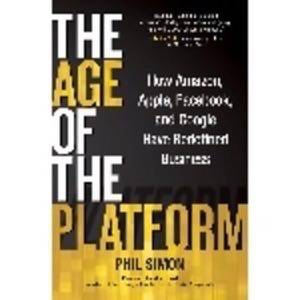There are many smart people out there – and few are smarter than Eric Schmidt.

Even before joining Google as chairman in August 2001, Schmidt was long regarded as one of the most respected, knowledgeable, and prescient technology minds on the planet. Among his many accolades, in 2007 PC World named him the most important person on the web – along with Google co-founders Larry Page and Sergey Brin. Today, there are few more astute observers in the field. When he talks, people listen.
Phil Simon is the author of four books on technology, including his latest, “The Age of the Platform: How Amazon, Apple, Facebook, and Google Have Redefined Business,” available on Amazon.
Schmidt was talking on May 31, 2011. He had the floor at the D9 Conference in Rancho Palos Verdes, California. In broad terms, he discussed today’s rapidly moving, tech-heavy economic climate.
Beyond generalities, though, Schmidt remarked that a small cadre of companies was growing at unprecedented rates, reaching scales that could only be described as extraordinary. Moreover, this growth had “not been possible before.” Schmidt named four companies that stood apart from the crowd: Apple, Amazon, Facebook and Google. He collectively referred to these companies as the Gang of Four.
Today the Gang of Four is light years ahead of its peers. And this lead is not just in one vital area, such as technology. In incredibly short periods of time, Apple, Amazon, Facebook and Google have done truly amazing things. They have built valuable brands, released popular products and services, cultivated widespread followings and generated enormous shareholder value and profits. They have quickly risen to prominence, in the process becoming the envy of thousands of organizations. They have been able to innovate and launch products, services and even entire lines of business at unprecedented rates. As we’ll see in this book, the source of these companies’ competitive advantages stems from many things, including profound customer insights enabled by troves of data, immensely valuable partnerships, highly adaptive cultures and the intelligent use of technology.
Big Company Syndrome
Historically, as large companies have grown to such dizzying heights, they have begun to show signs of fissure and eventual decline. Examples abound. IBM struggled mightily in the late 1980s and early 1990s. To be fair, it was able to successfully redefine itself as a service-oriented company, a turnaround that has been nothing short of astounding. Kodak was woefully unprepared for the rise of digital cameras and printing. More recently, many iconic organizations have lost their leads, sometimes in just a few years. Microsoft comes to mind and is discussed at length in Chapter 9 of this book.
It doesn’t take a genius to recognize the symptoms or diagnose the disease. After some degree of success, large organizations begin to tread water. Over the course of, say, five years, they start to exhibit the signs of stereotypical risk-averse, monolithic organizations. Again, this is well-trodden ground. Many books have been written about how size tends to encumber organizations, along with attendant bureaucracy and other baggage. Call it big company syndrome.
The Gang of Four, however, appears to be largely symptom-free.
It doesn’t take a genius to recognize the symptoms or diagnose the disease. After some degree of success, large organizations begin to tread water. Over the course of, say, five years, they start to exhibit the signs of stereotypical risk-averse, monolithic organizations. Call it big company syndrome.
Each company continues to hire thousands of new employees, enter new and often challenging markets, forge new partnerships and launch entirely new lines of business. These companies are doing much more than avoiding the traditional perils of growth, nor are they simply maintaining previous levels of performance. They are somehow increasing their organizational pace of innovation.
Disclaimer
I have no axe to grind with Microsoft, IBM, MySpace, AOL, Yahoo and other technology companies that have recently fallen from grace. On the contrary, I admire each company’s accomplishments and innovations. As we will see in Chapter 1, we would not be where we are today if Microsoft had not pushed for common computing standards, Yahoo! had not broken new ground with portals, AOL had not taken dial-up to the masses and MySpace had not introduced the idea of a social network to millions. In many important ways, these companies paved the way for the Gang of Four.
I only highlight the missteps of these organizations to underscore one of the key points in this book: Platforms – even great ones – do not guarantee long-term success. In other words, the platform is no silver bullet, and we can learn a great deal from the declines of these companies – and their platforms.
What’s more, I have great admiration for Amazon, Apple, Facebook and Google – and the leaders behind them. However, I do not mean to imply that the Gang of Four can do no wrong. In Part II of this book, I catalog some fairly large tactical and strategic blunders made by these companies. Throughout the book, I have endeavored to strike a balance between the good and the bad.
Let me be clear: Microsoft, Yahoo and their struggling counter-parts are not bad or incompetent organizations. Nor are Amazon, Apple, Facebook and Google above reproach. They are not run by inherently better or smarter people. But the fact remains: Each member of the Gang of Four has done an excellent job of building and managing its platform. And this is the main reason that each has enjoyed so much success over the last five years.
Bezos, Zuckerberg and company have learned a great deal from tech pioneers like Bill Gates and Jerry Yang. But now the pendulum has swung the other way. Current management at many organizations – including Microsoft, Yahoo and other besieged companies – would do well to study the success of Amazon, Apple, Facebook and Google. Hence the need for this book.
Get Big Fast
“At electric speed, all forms are pushed to the limits of their potential.” – Marshall McLuhan
In general, the Gang of Four is doing what top management gurus have been espousing for years. Specifically, they are embracing intelligent risk. They aren’t afraid of failure, experimentation and change. Innovation depends on this type of mentality. At least in part, each company has moved away from its original and core business model – often multiple times. They are sprouting in different and unexpected directions: horizontally, vertically and even diagonally. They have entered new markets, and in some cases, created markets where none had previously existed.
That’s one explanation. But it’s actually not the underlying reason for the massive and sustained success of these companies. Rather, they are winning because they are following an entirely new blueprint and business model. They have spent a great deal of time and money building extremely powerful and valuable ecosystems, partnerships and communities. This new model hinges on powerful ecosystems that, in turn, fuel astounding levels of innovation, profits and growth.
In the understated words of Eric Schmidt at the D9 Conference mentioned earlier, Amazon, Apple, Facebook and Google “are exploiting platform strategies really well.”
Without question, the Gang of Four has built the world’s most valuable and powerful business platforms. In so doing, these companies have done nothing short of redefining business. Collectively, they have introduced the platform as the most important business model of the 21st century. And they have spawned a litany of imitators. Thousands of companies are:
- Building their own platforms
- Creating valuable planks that complement existing platforms
- Modifying their business models to incorporate platforms
- Becoming platform partners
Welcome to the Age of the Platform.
Foresight in an Era of Constant Motion
It isn’t easy to conceive of, build and continuously adapt a platform. If it were, then everyone would be doing it. Amazon, Apple, Facebook and Google would be commonplace, not exceptional.
Expenses aside for a moment, creating a robust platform does not just hinge on consistently developing great products or services. Rather, it requires a completely different mind-set. It must be at the core of a company’s business model. Companies must not only exist, but they must thrive in a state of constant motion. They must embrace dynamic stability (discussed in Chapter 7). They need to constantly reevaluate and redefine basic precepts such as:
- What they currently do
- How they do it
- What they could do
- How they could do it
- With whom they do it
- How each piece interacts with other parts of its eco-system and the world at large
As Part II of this book will show, building such a platform requires many things. There is no five-step program or quick how-to guide. At the top of the list are amazing foresight, organizational agility and the courage to let third parties participate in a business frequently, and in some very unconventional and collaborative ways. Insular companies are unlikely to build a great platform.
Book Back Story
As 2011 progressed, I began to feel a compelling need to write a book about the platform as an important and new business model. As I will explain shortly, I have learned from personal experience that building a platform is not only beneficial, but also imperative for many companies’ survival. I look at myself as a case in point: In a relatively short period of time, I redefined my business and launched completely new products and services. How did I do this? In short, I built my own platform.
By way of background, from 2002 until 2008 with a few brief exceptions, my entire livelihood was tied to one fairly specific type of work: enterprise resource planning (ERP) consulting.
Even that type of relatively provincial work involves a wide variety of people and technical skills. Let’s just say, however, that more than 99% of all companies never considered engaging me. And probably 99.99% did not need me at any given time.
Despite this significant limitation, by 2008 I had started to come into my own. That year, I knocked the ball out of the park, making more money than at any other point in my life (nearly $250,000). I had concurrently balanced several difficult projects and had taken just one week off. For me, 2008 was the very definition of the “feast” year about which independent consultants like me dreamed – as in feast or famine. By any measure, I should have been ecstatic.
Yet, at least professionally, I was quite concerned. At the time, I was 36 years old. As I gave my accountant my third-quarter financial statements to prepare my taxes, I told myself: I had better enjoy this while it lasts, because it just couldn’t get any better. I couldn’t raise my rates forever and there were only so many hours in a year. Plus, rarely does an independent consultant like me move seamlessly from one project to another for an entire year as I just did. Downtime was a given in any economy, and ours was getting worse.
I knew that I needed to diversify and establish myself in different lines of business–or face dire consequences. But somehow that didn’t seem sufficient. I strongly suspected that I would have to refine my entire business model–and maybe even blow it up. In the long-term, this shift was necessary, but there was a short-term problem: No one cared. The world at large was not terribly interested in my decision to enter new lines of business – nor were many of my clients for that matter.
If I was going to be successful in diversifying and mitigating my own risk, I would have to build my own platform.
Simon 2.0
Fast forward to mid-2011. As I send my same accountant my quarterly financial reports, “Simon, Inc.” barely resembles the company of less than three years ago. That same type of consulting that generated more than $200,000 in revenue for me in 2008 is now barely a line item on my P&L statement. I had completely transformed my business. In part by accident and in part by design, over the next three years I launched entirely new lines of business. I earned money via services such as website design, writing, book coaching, marketing and other areas for which I had no formal training. I made money from book royalties and mobile app sales. I also started a publishing company and a public speaking practice. In large part, I would have not been able to pay my bills and continue working for myself if I had not built an effective platform.
As we’ll see later in the book, platforms are not elixirs. You still have to do the work. In my case, I had to develop a new brand and offer services that people would want–and pay for.
For three reasons, I’m glad that I started diversifying and building my platform when I did. First, I was beginning to tire of working on the same types of highly contentious projects.
Second, I wanted to tackle new challenges and continue my own professional development. Third and most important, my shift turned out to be an economic imperative. In hindsight, my timing could not have been better. By early 2009, ERP consulting had slowed to a trickle, and many of my colleagues had either lost their jobs or could not find work. Although I have yet to replicate the financial success of 2008 (and may never do so), my platform-based business model is much more sound and resilient to risk. I start each year with a fair amount of base income from my writing and speaking clients. What’s more, book sales generate passive income for me. Unlike years past, I no longer start at zero every January. As my platform continues to evolve in new and unexpected ways, it generates new income and opportunities for me.
Why These Four Companies?
As mentioned previously, I have been self-employed for most of the last 10 years. I am also a student of both technology and business – perhaps sponge is a better word. I am constantly absorbing information from myriad sources about technology and business trends, events and issues. Like any solopreneur, I have my ups and downs.
Expenses aside for a moment, creating a robust platform does not just hinge on consistently developing great products or services. Rather, it requires a completely different mind-set. It must be at the core of a company’s business model. Companies must not only exist, but they must thrive in a state of constant motion.
If I have a bad quarter – or three, as I did in 2009 – I wonder what I would do if I had to close my own little shop and work for a large company. And assuming it was my choice, where would I like to work? It would have to be a company that was:
- Doing extremely interesting and innovative things, especially with respect to emerging technologies.
- Adapting extremely well and quickly to change.
- Routinely introducing compelling new offerings.
- Working with partners in very exciting ways.
Which ones fit the bill? Which large companies are doing the most exciting things?
To me – and I don’t think I’m alone here – the answer is clear: Amazon, Apple, Facebook and Google. I certainly didn’t need Eric Schmidt to tell me as much. These four companies occupy elite status because of the popularity, reach and power of their platforms.
I knew that their extensive and successful use of platforms warranted a book. Against that backdrop, I started writing The Age of the Platform in April 2011.
In this book, I certainly don’t contend that Amazon, Apple, Facebook and Google are the only companies that understand the notion and importance of platforms – or at least make that claim.
(Chapter 10 provides examples of lesser-known platforms, and Chapter 11 covers powerful emerging platforms.) I focus on the Gang of Four in this book because their platforms are so popular and robust. What’s more, these four can teach businesses of all types and sizes many valuable lessons. To my knowledge, no existing book has looked at each of these dynamic organizations through the lens of the platform.
Very large companies such as Google and small companies like mine have embraced platforms – and seen amazing results. As a business model, the platform is size- and industry-agnostic.
I make no secret of my admiration for Amazon, Apple, Facebook and Google – and the leaders behind these amazing companies.
Yet, I have another reason for profiling them. Millions of people and small businesses concurrently do business with the Gang of Four in a wide variety of capacities. That is, we have symbiotic relationships with them. For instance, we earn money from Amazon as affiliates and then buy books on the site. We sell games and productivity apps on Apple’s AppStore and then spend money on an iPad or a MacBook Pro.
Why Buy This Book?
This book is first and foremost about the platform as a business model. It explains how Amazon, Apple, Facebook and Google have built dynamic and powerful ecosystems. Next, it lessons for creating and expanding your own platforms – and utilizing existing ones. Finally, it looks at the candidates for the next great platforms.
You might be asking yourself:
- Just what is a platform, anyway?
- Why are planks so important to platforms?
- Why does my law firm or accounting practice or widget factory need a platform?
- What can my business and I possibly learn from the platforms of Amazon, Apple, Facebook and Google?
- How is my small business remotely similar to these companies?
These are all fair questions. After all, relatively few businesses can spend billions or even millions of dollars on acquisitions – and afford to be wrong. Only a fraction of all companies have this type of liquidity and size. In fact, fewer than 1,000 American companies employ more than 10,000 people, according to the 2008 U.S. Census. In all likelihood, your business cannot be compared to Amazon, Apple, Facebook and Google.
But let me draw a few analogies here. One should not embark on a career in acting with the expectation of becoming the next Robert De Niro, Al Pacino, or Meryl Streep. Foolish is the guitarist who starts a band with the hope of selling more records than the Beatles. The upstart novelist who expects to be the next John Grisham or Stephen King had better not quit her day job. Ditto the teenager who picks up a tennis racket with dreams of being Roger Federer incarnate. The odds that any of these things will happen are beyond remote.
We can still learn a great deal from these extremely talented and successful people. Iconic actors, artists, musicians, writers and athletes have achieved their levels of prominence because they are doing so many things right. Luck and innate ability can only explain so much. I can’t hit a forehand like Roger Federer, but I certainly can learn a few things by watching him on the court.
The same principle applies to the business world. It may not be realistic to compare your company to Amazon, Apple, Facebook and Google, but you can still learn a great deal from them and their platforms. And your business can benefit from these lessons.
I wonder what I would do if I had to close my own little shop and work for a large company. And assuming it was my choice, where would I like to work? It would have to be a company that was:
- Doing extremely interesting and innovative things, especially with respect to emerging technologies.
- Adapting extremely well and quickly to change.
- Routinely introducing compelling new offerings.
- Working with partners in very exciting ways.
In a nutshell, these are the goals of this book.
Aside from examining the platforms of Amazon, Apple, Facebook and Google, this book profiles a number of smaller companies that have built impressive platforms.
The Structure of This Book
The Age of the Platform is organized into four parts. Part I provides the framework and background for the remainder of the book. It takes a look at the technological, societal and economic trends and developments that have led to the emergence of the modern-day platform. A number of key trends and events have allowed Amazon, Apple, Facebook and Google to build powerful platforms. Before examining each company and its platform, we need to consider the context in which it is operating.
Part II looks at today’s great platforms and the companies behind them. We’ll see how external parties such as customers, users, developers, partners and vendors extend platforms’ reach. The focus is on the Gang of Four. Besides providing brief histories of these organizations, Part II examines how they have created such transformative platforms – and why they are generating such incredible results. It shows that, by building powerful platforms, Amazon, Apple, Facebook and Google have become admired and valuable companies. Part II explores how these companies benefit immensely from their platforms – and of equal importance, allow their partners to benefit as well. Moreover, companies don’t build powerful platforms by doing only one thing – even if they do that thing really well.
Part III takes a step back. It synthesizes the lessons of the previous four chapters. It looks at the components, characteristics, benefits and perils of the platforms. Part III concludes by providing lessons for building your own platforms.
Part IV looks at the powerful platforms of the future, provides a brief synopsis of the book and boldly offers a few predictions.
What Will I Learn By Reading This Book?
That is probably the burning question in your mind right now. You will gain a profound understanding of the importance of the platform. You’ll learn how the Gang of Four – and other companies – is utilizing these ecosystems in all sorts of innovative ways.
“Give me the place to stand, and I shall move the earth.” – Archimedes
Granted, this knowledge alone will not enable your company to usurp Google in search. Although your company might sell more stuff on Amazon’s platform, it will not sell more stuff than Amazon.
Neither scenario is realistic, and I am not a fan of business books that make grandiose promises such as these. But this much I vow: After reading this book, you will know why platforms matter today more than ever. And you’ll understand the importance of how platforms are changing business in many profound ways.
Let’s go!

















